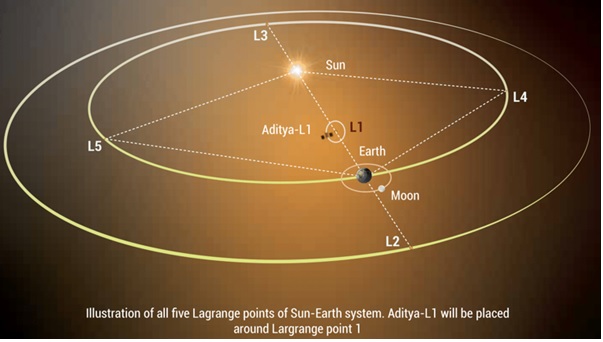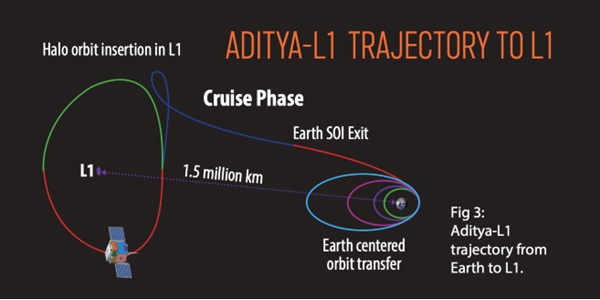ISRO launches India’s first solar mission, Aditya L1 from Sriharikota
September 02, 2023
Sriharikota: Indian Space Research Organisation (ISRO) has successfully launhed its first-ever mission to study the Sun, shortly after making history by being the first to land near the Moon’s south pole.
The Aditya-L1 spacecraft was launched from Sriharikota today at 11:50 AM. It’s going to travel quite far from Earth, about 1.5 million kilometres (which is just 1% of the distance between Earth and the Sun). It will take about four months to reach that distance, according to India’s space agency.
Aditya-L1 is a satellite dedicated to the comprehensive study of the Sun. It has 7 distinct payloads developed, all developed indigenously. Five by ISRO and two by Indian academic institutes in collaboration with ISRO.
Aditya in Sanskrit means the Sun. L1 here refers to Lagrange Point 1 of the Sun-Earth system. For common understanding, L1 is a location in space where the gravitational forces of two celestial bodies, such as the Sun and Earth, are in equilibrium. This allows an object placed there to remain relatively stable with respect to both celestial bodies.
Following its scheduled launch that was successful, Aditya-L1 stays Earth-bound orbits for 16 days, during which it undergoes 5 maneuvres to gain the necessary velocity for its journey. Subsequently, Aditya-L1 undergoes a Trans-Lagrangian1 insertion maneuvre, marking the beginning of its 110-day trajectory to the destination around the L1 Lagrange point. Upon arrival at the L1 point, another maneuvre binds Aditya-L1 to an orbit around L1, a balanced gravitational location between the Earth and the Sun. The satellite spends its whole mission life orbiting around L1 in an irregularly shaped orbit in a plane roughly perpendicular to the line joining the Earth and the Sun.
The strategic placement at the L1 Lagrange point ensures that Aditya-L1 can maintain a constant, uninterrupted view of the Sun. This location also allows the satellite to access solar radiation and magnetic storms before they are influenced by Earth’s magnetic field and atmosphere. Additionally, the L1 point’s gravitational stability minimizes the need for frequent orbital maintenance efforts, optimizing the satellite’s operational efficiency.
The Sun is a giant sphere of gas and Aditya-L1 would study the outer atmosphere of the Sun. Aditya-L1 will neither land on the Sun nor approach the Sun any closer.
PM Modi congratulated scientists and engineers of ISRO for the successful launch of India’s first Solar Mission, Aditya -L1.
In a X post, the Prime Minister said, “After the success of Chandrayaan-3, India continues its space journey. Congratulations to our scientists and engineers at @isro for the successful launch of India’s first Solar Mission, Aditya -L1. Our tireless scientific efforts will continue in order to develop better understanding of the Universe for the welfare of entire humanity.”
After the success of Chandrayaan-3, India continues its space journey.
Congratulations to our scientists and engineers at @isro for the successful launch of India’s first Solar Mission, Aditya -L1.
Our tireless scientific efforts will continue in order to develop better…
— Narendra Modi (@narendramodi) September 2, 2023
Union Home Minister and Minister of Cooperation Amit Shah also congratulated ISRO for successful launch of India’s first solar mission, Aditya L1. In his post on ‘X’ Shri Amit Shah said time and again our scientists have proved their might and brilliance. The nation is proud and delighted over the successful launch of Aditya L1, India’s first solar mission. Kudos to the team ISRO for this unparalleled accomplishment.
Home Minister said that it is a giant stride towards fulfilling Prime Minister Shri Narendra Mogi ji’s vision of an Atmanirbhar Bharat in the space sector, during the Amrit Kaal.
Time and again our scientists have proved their might and brilliance. The nation is proud and delighted over the successful launch of Aditya L1, India’s first solar mission.
Kudos to the team @isro for this unparalleled accomplishment. It is a giant stride towards fulfilling PM… pic.twitter.com/XEacBvLxoj
— Amit Shah (@AmitShah) September 2, 2023


Recent Stories
- One held in Ahmedabad for selling urea fertilizer; 1188 bags seized
- MEA Jaishankar visits National Maritime Heritage Complex, Lothal
- ACB Gujarat nabs Dy Mamlatdar, aide in bribe case in decoy trap
- Locals object to public preaching by missionaries in Ukai; video goes viral
- Illegal properties of bootleggers bulldozed in Ahmedabad
- Over 61 lakh rural citizens benefit from Digital Seva Setu in 2 years: Gujarat govt
- Gujarat govt approves DA hike under 6th & 7th Pay Commissions; over 9 lakh to benefit
